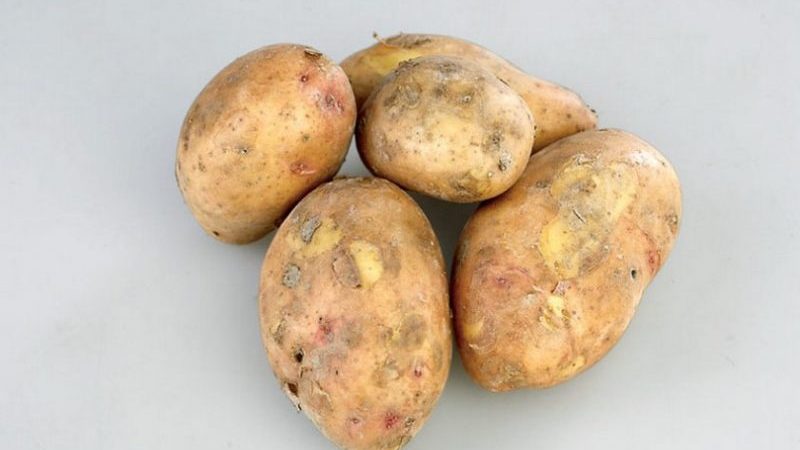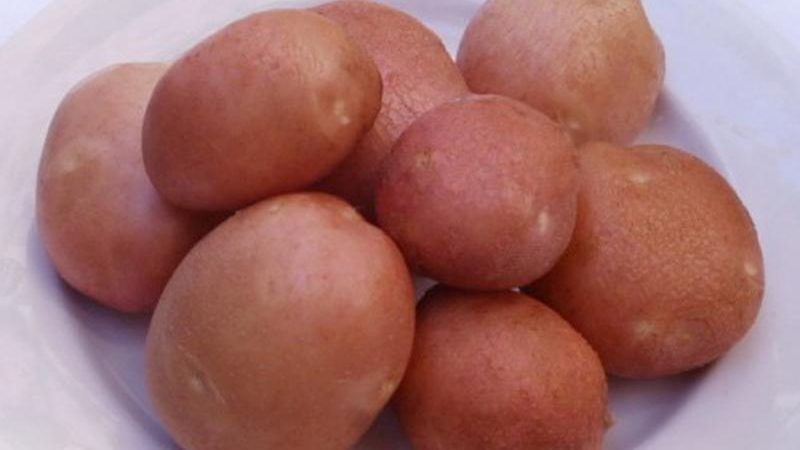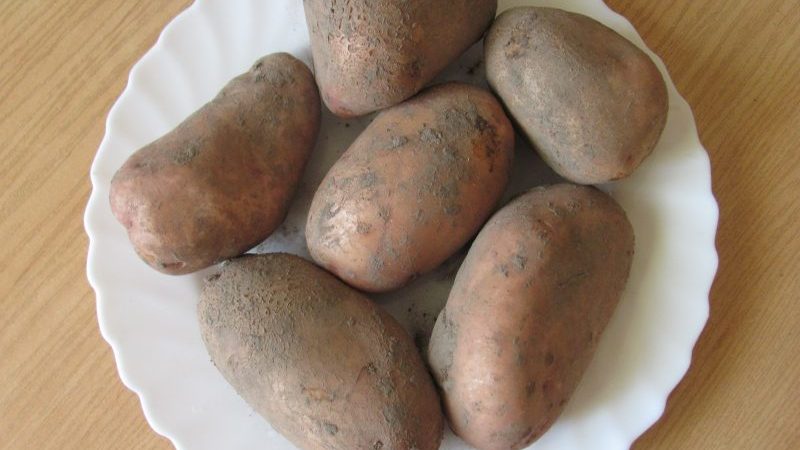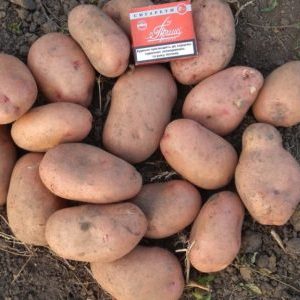Mid-season potato variety "Slavyanka" with large tubers
Slavyanka is considered to be one of the best potato varieties. Due to the consistently high yield, excellent taste and marketability, as well as minimal care needs, it stands out favorably against the background of other varieties and is in stable demand among gardeners.
The content of the article
Description of the variety
Slavyanka - a variety of table use, the tubers of which are suitable for frying, baking, stuffing, as well as making french fries and chips.

Origin and development
Slavyanka potatoes were bred by breeders of the Ukrainian Academy of Agrarian Sciences on the basis of virus-free seed material.
reference! The variety was entered into the state register of the Russian Federation in 2009.
Chemical composition, trace elements and vitamins
The pulp contains 11.1-13.4% starch, as well as many useful trace elements, in particular, potassium, B vitamins, amino acids.
Ripening period
Slavyanka belongs to mid-season potato varieties - the harvest is ready for harvesting 100-120 days after planting the tubers.
Yield
The variety is characterized by a fairly high yield, which does not depend on weather conditions: on average, 12-15 tubers can be harvested from a bush, and the maximum yield per hectare is 392 centners.
Disease resistance
Slavyanka potatoes are immune to leaf curling, blackleg, potato crayfish, tobacco or wrinkled mosaics and golden cyst nematodes, as well as moderate resistance to late blight.
Characteristics of tubers, description of appearance
The bushes are moderately spreading, reaching a height of no more than 50 cm. Leaves with slightly wavy edges, open, dissected, colored dark green and slightly pubescent. During the flowering period, small bluish-purple flowers are formed on the bushes.
The tubers are large (90-180 g), even, neat oblong-oval shape, covered with a thin and smooth skin, evenly colored pink-purple.
The pulp is creamy in color, has a pleasant taste, does not change color and shape when cooked.
What regions are best suited for and climate requirements
Slavyanka potatoes prefers a temperate continental climate and is recommended for cultivation in the Central Black Earth Region (Belgorod, Voronezh, Kursk, Lipetsk and Tambov Regions), but it is successfully cultivated in almost all regions of Russia, in Ukraine it is one of the most popular varieties.
The main advantages and disadvantages of the variety

The undoubted advantages of the variety include:
- high productivity and commercial qualities;
- pleasant taste;
- resistance to a number of characteristic diseases;
- good keeping quality and no problems with transportation;
- unpretentiousness to climate and weather conditions;
- amicable ripening.
Disadvantages:
- low resistance to mechanical damage;
- exactingness to the frequency and amount of dressings;
- the tendency to damage apical, root and gray rot.
What is the difference from other varieties
The table shows the differences between Slavyanka and a number of other popular potato varieties:
| Variety | Ripening terms | Productivity, c / ha | Starch content,% | Keeping quality,% | Tuber mass, g |
| Slav | 100-120 | Up to 400 | 11,1–13,4 | 95 | 90-180 |
| Rocco | 100-150 | 350-400 | 13-16 | 89 | 100-125 |
| Rosara | 65-70 | 415 | About 13 | 95 | 80-115 |
| Aurora | 60-80 | Up to 400 | 14-17 | 94 | 90-150 |
| Tuleyevsky | 80-110 | 180-300 | 14-16 | 90 | 200-300 |
Features of planting and growing
The technology of growing Slavyanka practically does not differ from the cultivation of other varieties of potatoes. Of course, there are some nuances that must be taken into account in order to obtain a high-quality harvest, but in general this variety can be grown not only by an experienced, but also by a novice gardener.
Preparing for landing
As a seed, use smooth medium-sized tubers, but which should not be rot, stains, cracks and other visible defects.
Before planting in the ground, they are disinfected by soaking for half an hour in a weak solution of potassium permanganate, after which they are well dried. Also, root vegetables can be kept in a solution of "Epin" or "Kornevin" for 30 minutes - this will accelerate germination, increase the immunity and yield of the variety.
They begin to prepare the soil a month before planting potatoes. The soil is dug up and fertilized with humus, wood ash and nitrophosphate, and onion peels are placed in each hole to scare away wireworms. For 7-10 days before planting, the soil must be re-dug up onto a half bayonet of a shovel.
Ground requirements
The Slavyanka variety adapts well to any soil and does not impose any special requirements on it. It is only important that the soil is fertile and has good moisture permeability and aeration.
Timing, scheme and landing rules
The term for planting potatoes in open ground depends on the climatic conditions of the region. On average, you can start planting in mid or late April, when there is no threat of frost return, and the soil has warmed up to + 10-12 ° C.
Important! To protect against possible frosts, especially in the northern regions, the beds are covered with polyethylene.
To obtain a high-quality and bountiful harvest, adhere to the planting agrotechnics:
- mark the rows at a distance of at least 70 cm from each other;
- dig holes in them, the distance between which should be at least 35 cm;
- pour compost, humus or wood ash into each hole;
- lay the seed to a depth of 8-10 cm;
- dig in with earth and level with a rake.
If the beds are small, it is better to use the trench planting method:
- dig a trench 25 cm deep and 35 cm wide;
- pour compost and plant residues on the bottom;
- put the tubers on top;
- cover the planting with a small (2-3 cm) layer of soil.
Next to the resulting trench, at a distance of 70 cm, dig another one, from which the soil will later be used for hilling.
Growing features

To make the experience of growing Slavyanka positive, follow the basic rules:
- plant potatoes only in well-heated and prepared soil;
- choose a flat, well-lit place on the site where moisture does not accumulate;
- watch out for drafts and strong gusts of wind.
Important! The place for planting Slavyanka is changed at least once every three years, since potatoes deplete the land.
The nuances of care
To obtain a plentiful and high-quality harvest, observe the terms and rules of agricultural technology.
Watering mode
Water the plant regularly, focusing on the degree of soil drying. With a sufficient amount of natural precipitation, it is enough to water the potatoes only three times per season: when the height of the green part is 10-15 cm, during and after flowering.
Slavyanka tolerates short-term drought well, but long-term lack of moisture leads to a decrease in the size of tubers, and excessive watering provokes the development of fungal diseases.
reference! The most suitable solution is to install a drip irrigation system.
Top dressing
The Slavyanka variety is picky about feeding. To increase yields and improve the protective functions of potatoes, fertilize it in stages:
- before hilling, 10 g of ammonium nitrate and 300 g of humus are applied under each bush, or mullein is used in a ratio of 1:10;
- during budding, the plant needs potassium, which is contained, for example, in ash (100 g per bush);
- after wilting, but before the active development of tubers, the soil must be shed with a superphosphate solution (30 g per 10 l of water).
During the growing season, every 14 days to increase the resistance of the crop to diseases, magnesium is introduced into the soil: in the area where the soil has neutral or weak acidity, magnesium sulfate is used, dolomite flour (50 g per 1 sq. M.) Is added to the acidic soil.
Weeding and hilling
Weeding the bushes is carried out immediately after the appearance of the first shoots and then as needed - it depends on the growth rate and spread of weeds.
Hilling is carried out twice: when the bushes reach 15-20 cm in height and before flowering. This procedure contributes to the saturation of the soil with oxygen and nutrients, as well as the activation of the growth of side shoots.
The soil should be moist, so it is better to huddle after rain or watering.
Disease and pest control
Slavyanka has the least resistance to late blight, a disease characterized by the appearance of dark spots on the leaves and their subsequent decay. Over time, the disease affects the stem and tubers, so the bushes are treated with preparations that contain copper, otherwise there is a risk of crop loss.
It is possible to avoid the development of late blight if:
- observe crop rotation;
- store only whole, healthy tubers;
- do not carry out evening spraying;
- harvest on time, and dry the harvested tubers in the sun;
- huddle bushes.
If we talk about pests, then most often Slavyanka is attacked by Colorado beetles, bears, aphids, wireworms, butterflies, spider mites, potato moths, leafhoppers. You can get rid of them with the help of insecticides "Prestige", "Anti-Colorada", "Aktarofit".
Important! Plants should not be treated with chemicals two weeks before harvest.
Harvesting and storage
Withering and dropping of the stems testifies to the readiness of the crop for harvest. As soon as this becomes noticeable, they dig in one bush and check the degree of ripening of the potatoes: if the skin on the root crops has become strong, you can start mass harvesting.
How and when to collect

Harvested in early or mid September. Since the variety is not resistant to mechanical damage, it is better to pick the tubers by hand, but if the area is large, you can use a harvester with a side grip.
Storage features and keeping quality of the variety
The harvested tubers are left for 2-3 hours in the sun so that they dry out, and then they sort out, getting rid of the rotten ones, postpone those that will then be used for planting and further storage.
The best potatoes are put in wooden boxes covered with burlap or oilcloth, bags or nets and lowered into the basement, cellar or basement, where the air temperature should be + 2-4 ° C, and the humidity should be 80-95%. The keeping quality of the variety is 95%.
What can be the difficulties in growing
In the process of growing Slavyanka, summer residents face such problems as:
- chopping tubers due to lack of watering;
- rotting of potatoes due to excessive moisture;
- low germination due to improper preparation of the seed.
You can avoid these and a number of other problems by observing potato planting rules and subsequent care for him.
Tips from experienced gardeners and reviews about the Slavyanka variety
Gardeners are satisfied with the yield, taste and commercial qualities of the variety. This is confirmed by numerous reviews.
Marina, Samara: «My husband and I have been growing Slavyanka for many years and do not plan to change anything.This potato completely suits us - the harvest is large and well stored, the potatoes are large, tasty, I like that they are not strong boiled over when cooking. "
Lyudmila, Saransk: "Last year, the neighbors treated them to potatoes - very tasty and large. I asked them the grade and it turned out that it was Slavyanka. I heard a lot about this variety and now, after I had a chance to try it, I decided to plant a couple of beds for testing. The result exceeded expectations - she harvested 25 kg of potatoes and 1 sq. m. of land. I didn't check it for keeping quality, because they ate everything quickly. I will plant more next year. "
Pavel, Dimitrovgrad: “Slavyanka has just a lot of advantages: the harvest is large, the potatoes are tasty, all large, small ones come across, of course, but very few. There is practically no need to look after - a very unpretentious variety. But there is one drawback all-such - it is necessary to harvest the crop very carefully, because the tubers are easily damaged, and this very badly affects their storage. "
Read also:
An early ripe, frost-resistant potato variety "Rosalind".
Conclusion
The Slavyanka potato variety managed to gain popularity among gardeners in Russia and Ukraine. This is not surprising, since it can guarantee a bountiful and high-quality harvest, show resistance to many diseases and taste good without requiring laborious maintenance.